Description 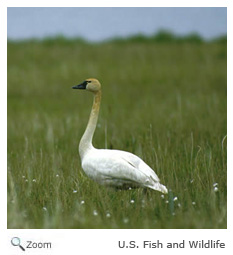 The tundra swan is 47-58 inches in length with a wingspan of about 66 inches. It is completely white and has a round head, a long neck, a long black bill, a black face, and
black feet and legs. It may have a yellow spot in front of its eyes. The tundra swan is 47-58 inches in length with a wingspan of about 66 inches. It is completely white and has a round head, a long neck, a long black bill, a black face, and
black feet and legs. It may have a yellow spot in front of its eyes.
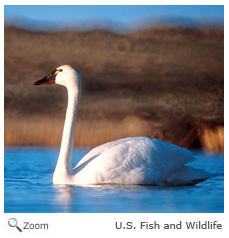 The tundra swan, unlike the mute swan, holds its neck up straight when swimming. Males and females look alike, but the male is usually a little larger. The tundra swan is the only swan native to the eastern U.S. The tundra swan, unlike the mute swan, holds its neck up straight when swimming. Males and females look alike, but the male is usually a little larger. The tundra swan is the only swan native to the eastern U.S.
Range 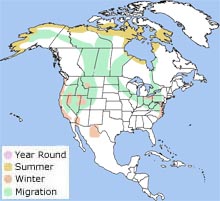 The tundra swan breeds
in the Arctic regions of northern Canada and Alaska. There are two populations of tundra swans in North America, one in the east and one in the west. Both populations migrate over 3,000 miles each season. The eastern population winters on the Atlantic Coast from the
Chesapeake Bay to North Carolina. The western population winters on the
Pacific Coast from southern British Columbia to southern California. Small groups also winter in interior portions of the west and on the Great Lakes. The tundra swan also breeds in Siberia. The tundra swan breeds
in the Arctic regions of northern Canada and Alaska. There are two populations of tundra swans in North America, one in the east and one in the west. Both populations migrate over 3,000 miles each season. The eastern population winters on the Atlantic Coast from the
Chesapeake Bay to North Carolina. The western population winters on the
Pacific Coast from southern British Columbia to southern California. Small groups also winter in interior portions of the west and on the Great Lakes. The tundra swan also breeds in Siberia.
Habitat
The tundra swan
breeds on
the Arctic tundra and winters on
salt water bays, estuaries, and marshy lakes, rivers, ponds, streams, and flooded fields.
| |
Diet
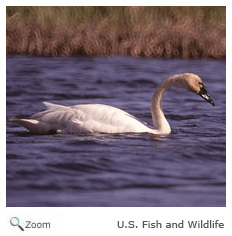 The tundra swan feeds in flocks in shallow water. It plunges its long neck underwater and tips up its rear to feed on the tubers and roots of aquatic plants. It also eats mollusks and grains. The tundra swan feeds in flocks in shallow water. It plunges its long neck underwater and tips up its rear to feed on the tubers and roots of aquatic plants. It also eats mollusks and grains.
Life Cycle 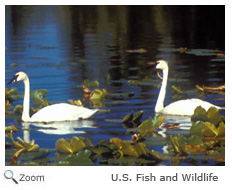 Male and female courtship begins in the late winter and continues into the spring. The male and female face each other, stretch out their wings, and bow their heads at each other. Both the male and female build a
large mound of vegetation with a bowl-shaped depression in the middle and line it with down.
The female lays 3-5 eggs. Male and female courtship begins in the late winter and continues into the spring. The male and female face each other, stretch out their wings, and bow their heads at each other. Both the male and female build a
large mound of vegetation with a bowl-shaped depression in the middle and line it with down.
The female lays 3-5 eggs.
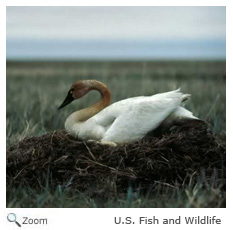 The female incubates the eggs for
32-34 days while the male guards the nest site. Both parents care for the cygnets, who can swim and feed themselves shortly after birth but still need to be brooded or sat on by a parent to keep warm on the cold tundra. The cygnets migrate with their parents in the fall and stay with them through the winter. Male and female pairs usually mate for life. The female incubates the eggs for
32-34 days while the male guards the nest site. Both parents care for the cygnets, who can swim and feed themselves shortly after birth but still need to be brooded or sat on by a parent to keep warm on the cold tundra. The cygnets migrate with their parents in the fall and stay with them through the winter. Male and female pairs usually mate for life.
Behavior
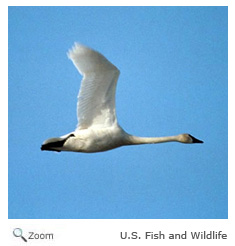 The tundra swan was once called the
whistling swan
because of the sound its powerful wings make when it is in flight. The tundra swan was once called the
whistling swan
because of the sound its powerful wings make when it is in flight.
|

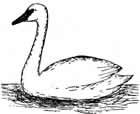


 The tundra swan breeds
in the Arctic regions of northern Canada and Alaska. There are two populations of tundra swans in North America, one in the east and one in the west. Both populations
The tundra swan breeds
in the Arctic regions of northern Canada and Alaska. There are two populations of tundra swans in North America, one in the east and one in the west. Both populations 


